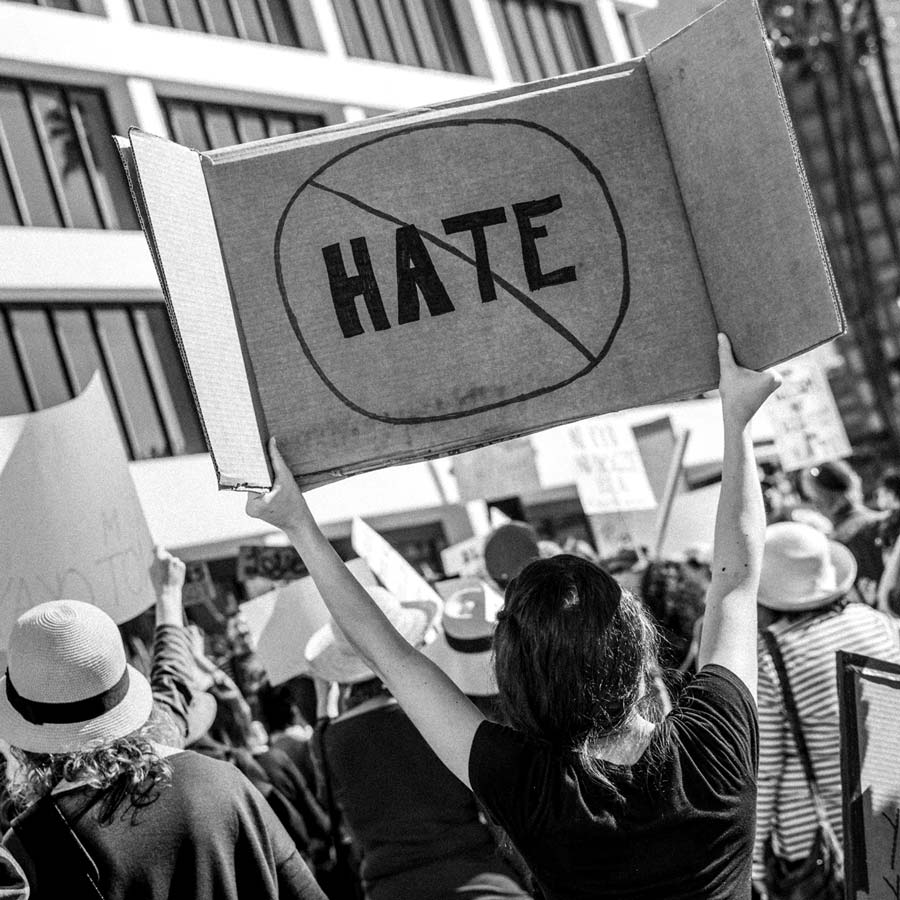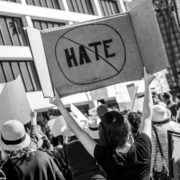
As the world continues to fight the new coronavirus, the global Asian and Pacific Islander community pushes back on hate, discrimination
There are fewer global phenomena that make a bigger impact than a viral pandemic.
As told by history, the emergence of a new, deadly pathogen — especially one for which there is no known cure or robust preventative measure — stops the world, disrupting everyday life for all humans in a way that permanently impacts the zeitgeist.
COVID-19, which stands for coronavirus disease 2019, is a specific disease caused by a virus named SARS-CoV-2 and stems from a family of viruses called the coronaviruses (named so due to the crown-like spikes that cover the virus’ surface). Coronaviruses can also trigger a wide range of known ailments from the common cold to more severe diseases like severe acute respiratory syndrome (SARS) and Middle East respiratory syndrome (MERS).
As most people are acutely aware, COVID-19 is the latest disease to rock the world, transforming and, hopefully, advancing the ways in which we deal with global health crises in a time where humans are more connected than ever.
In the same way that the virus itself has rapidly disseminated across cities, counties, states and countries, so have broad isolation measures to stop the spread of disease. The World Health Organization (WHO) and the U.S. Centers for Disease Control and Prevention (CDC) have both urged governments to enact such measures.
Last week, California became the first state to implement a statewide stay-at-home order for its nearly 40 million residents, and shortly after more than a dozen states followed suit.
The COVID-19 outbreak is multi-faceted and affects all areas of modern life. School districts have shut down and there are currently efforts to compensate workers of all industries and provide ample sick pay as more governments adopt stay-at-home measures.
As of press time, much of the world has adjusted to this restrictive stasis. The WHO has praised both China and South Korea for “flattening the curve” but in other countries, like the U.S., the virus’ impact continues to inflate and seep into all areas of American society.
Averting another recession
As it is with most things in the United States, all roads lead to the economy, and how to mitigate capital damage during this outbreak and amid stay-at-home orders. President Donald Trump, who prior to announcing a national emergency on March 13 downplayed the virus’ impact on the United States, and his administration have prioritized the prevention of a major economic fallout.
On Tuesday, March 24, the Trump administration (led by Treasury Secretary Steve Mnuchin) and Congress negotiated a $2 trillion stimulus package, the largest emergency stimulus package in American economic history.
In short, the Senate bill would direct one-time payments of $1,200 to most American adults; establish a $500 billion lending program for companies, states, and cities; extend $367 billion for small businesses to deal with payroll issues; strengthen the unemployment insurance system and funnel $150 billion toward hospitals.
After weeks of plummeting and experiencing its biggest one day decline since the 1980s, the Dow Jones Industrial Average has risen 2,113 points in one day in anticipation of the Congress bill, providing optimism for airlines and the cruise lines, two industries which have taken a toll since the outbreak began.
Indeed, the economic impact has dominated much of coronavirus-related news and developments coming from Washington. And as previously reported in the Asian Journal, Trump has argued against the expansion of testing for COVID-19 and placed focus on economic damage control. (Trump said that he wants the “country opened” by Easter.)
But despite the efforts to save the economy and protect the private sector from financial ruin, the number of people testing positive for the virus is skyrocketing. According to a New York Times interactive, at least 52,215 people across the U.S. have tested positive for the virus as of Tuesday. Moreover, 675 U.S. patients have so far died from coronavirus-related causes.
What began as a regional scare in Wuhan, China last year has accelerated to become a global panic that has preyed on the fears of the public. The natural reaction to the media reports of death tolls and lockdown announcements has triggered panic behavior that reflects the tendency for some people to cling on to misinformation and hysteria.
Public health scares and minorities in America: an ugly history
Like any government agency, a public health care system is meant to provide care to all patients who enter its facilities, a service which, ideally, is void of any discriminatory standards.
But in the United States, a country with a tainted history of xenophobic and racist policies and practices, that unsurprisingly wasn’t always the case.
A 2004 study from the American Journal of Public Health that explored Depression-era standards and practices towards Mexicans and Filipinos in Los Angeles detailed the extensive effort to rid sick Filipinos from hospitals and, eventually, deport them.
After thousands of Mexicans left the state and reduced hospitals’ occupancy, leaving clinics and hospitals reduced, the California State Board of Health worried that the hospitals would now be taken over by sick Filipinos, calling them “one of our worst problems at the present time.”
In 1933, the Director of the State Bureau of Tuberculosis Edythe T. Thompson wrote with hostility in her inspection reports of the state’s public hospitals about Filipinos and supported the campaign for Filipino repatriation, the government’s attempt to strip Filipinos in the U.S. of their American nationality and send them back to the Philippines. (The Philippines was still a U.S. territory which meant that Filipinos who came to the U.S. for work were considered “U.S. nationals.”)
After a visit to Kern General Hospital in Bakersfield, Thompson wrote, “Here, as in many of the other general hospitals, the beds on the tuberculosis service were nearly all filled with Filipinos. These people seem to have more complications than other races.”
Thompson went on to write that Filipino hospital patients “require very much more nursing than a white patient, and since they are so often disturbed mentally, coupled with certain groups of them carrying many superstitions, it makes life very miserable for white patients around them.”
According to a monthly report quoted in the 2004 study, Thompson wrote in 1934 that “Filipinos, like Mexicans, deserved only the cheapest and least attractive types of care,” punctuating a suggestion from the California State Board of Health to Congress that Filipinos in California should be returned to the Philippines “on army transports.”
These attitudes towards Filipinos are exemplary of the ways in which a culturally-stunted society can and have disenfranchised minorities by way of a medical crisis: using health scares as an excuse to implement nativist policy changes.
“We have a long history of using science and medicine to justify racism,” Gilbert Gee, a professor in community health sciences at UCLA’s Fielding School of Public Health, told the Asian Journal in a recent phone interview.
Though the tuberculosis scare wasn’t a pandemic, it is exemplary of the ways in which both government officials and scientists of yore have justified discriminatory practices.
In his academic research, Gee has written extensively on the murky relationship between medical science and racial discrimination in which prominent doctors have argued that “different racial groups carry certain kinds of diseases and that these things are higher among certain groups because they’re essentially biologically, mentally, and socially inferior.”
Gee provided the example of the prominent antebellum-era physician Samuel Cartwright who argued that certain racial groups are “innately different in their fundamental physiology,” an argument that has since been debunked by the scientific community at large.
Like Thompson’s view that Filipinos with tuberculosis are innately more dangerous than white tuberculosis patients, Cartwright used this warped perspective to justify slavery as a biologically necessary institution.
A disease by any other name
Nominally, it was standard practice to name diseases after the place from which they originated. In the 1950s, the H2N2 outbreak was colloquially called the “Asian flu” and before that in 1947, the Zika virus was so-called after the Ziika Forest of Uganda from which the dengue-like infection began.
Since the beginning of the COVID-19 outbreak, some people, including American lawmakers, have adopted the misnomer “Wuhan virus” or “China virus” to describe the COVID-19 virus. Though it has historically been standard practice to name viruses as such, it poses a problem on how the public associates the infection and, specifically, who has the infection.
As previously reported by the Asian Journal, the number of hate directed toward the Asian and Pacific Islander community has risen considerably. Viral social media posts detailing verbal and physical harassment against Asians accused of carrying the virus have proliferated timelines, harkening back to the racist and xenophobic attitudes of the past.
Anger and panic are natural responses to a global health crisis, but racism and xenophobia stunt any efforts to eradicate the virus, which health officials have repeatedly noted are not tied to certain races and ethnicities.
So while it is important if someone is showing symptoms to immediately address the situation and provide medical attention, “it doesn’t make sense to just kind of blanketly treat people in a discriminatory fashion just because they look a certain way or have a certain name,” Gee said.
Though Gee expressed frustration at the stories of anti-AAPI hate, he did acknowledge the need to decouple racism from “our social systems” and provide a better way of surveilling discrimination and hate, especially during a massive health crisis.
In an effort to combat anti-AAPI sentiments, a new coalition of AAPI leaders and advocacy groups unveiled the STOP AAPI Hate Reporting Center, which was created “to collect and track incidents” of anti-AAPI “hate, violence and discrimination” across California and the U.S.
The center was established by Asian Pacific Islander Legislative Caucus Chair Assemblymember David Chiu (D-San Francisco) and other caucus members, including Filipino American Assemblymember Rob Bonta (D-Oakland), who said in a statement that his goal is “to ensure we are using the data of racially motivated incidents to inform state policy and budgetary investments to curtail racial discrimination and harassment.”
The very existence of a coalition like this is a sign that the culture has changed dramatically since the days of Edythe Thompson and the days in which policymakers supported the campaign to deport sick Filipinos. As the number of cases and deaths continue to skyrocket, there’s no telling when or if the virus will be contained.
“The reality is that we will continue to see more outbreaks like this. There’s always going to be new diseases that emerge on earth,” Gee said, noting the rapid expansion of technology that has made it easier to travel and connect with people on all four corners of the world.
But, if anything, the current moment can be seen as a lesson in the human reaction to worldwide health catastrophes, and the tendency for humans to act out based on fear.
“There are seven and a half or so billion people on earth, with maybe 1.5 billion people from China and another billion or so from India. So if you think about it, roughly two out of five people on this planet are from Asia, so the likelihood of a new disease emerging from Asia is actually kind of high. That being said, we need to really pay attention to decoupling diseases with groups of people,” Gee said.






